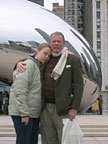Pier Luigi Tazzi
delightfully describes Kapoor’s work as ‘irregular like holy
places, the landscape of the soul’ not intellectual design but the
imperative of holy sites of gods and desire. Soulfully, he observes that
Kapoor’s sculpture with its pure color or pitted stone should ideally
be below the level of the earth, in caves or under the sea. Art may offer
a darshan of reality, Kapoor offers delight, damp, velvety, colored shadows,
female wounds, hurt lips, perhaps remembering the ‘Rivers of Blood’
predicted by Enoch Powell. 'Flowing, organic, Japanese' come to mind,
or inspired by liquid mercury as Kapoor says.
Kapoor was asked by Naples
to build a Metro station. He thought they wanted a few thoughtful, sympathetic
installations but was astonished when they talked about the entire station.
He then created a giant work of art, to enter like a loose, knitted garment,
not simply engineering, but an insistent reminder of travel and art.
Some more of his work: ‘Suck’ is like the Hindu void, with
no beginning and no end, unimaginable eons of time. His huge Marsyas,
gives a sense of being flayed, like in the legend. The sculpture’s
dark red colour suggests something ‘of the physical, of the earthly,
of the bodily.’ Kapoor simply commented, ‘I want to make body
into sky'. and added, “The Turbine Hall is a giant space. Most earlier
exhibits used one-third of it. I decided I would use the whole building.
It was the only way I could make sense of it.”
| |

Cloud
Gate
|
“Bigger isn’t
better. Scale is one of the possible forces or energies,” says the
artist about his 25-metre long stainless steel installation, tall and
high, near Lake Michigan. Locally loved and called ‘Silver Bean’,
it reflects viewers and the city. The 110-ton ‘Cloud Gate’,
forged from seamless polished stainless steel "plates" reflects
and refracts Chicago’s skyline with the park hovering near and around
it. Often his entire sculpture cannot be seen or even sensed from one
position: we do get separate views but do not ever feel we possess it.
‘At the Edge of the
World II’ takes your thoughts from the mortal to the immortal.
His assorted works show mastery over power, powder and pigment and offer
us belief, passion, and transcendental experiences. His work is in curves,
often in deep monochrome or with bright pigments with powder sometimes
lying on the floor, like India’s rangoli heaps.
‘My red homeland’
is a cylindrical 12 meters in diameter made from 20 tons of deep-red Vaseline,
offering a depiction of chaos and pralaya, the ascent and descent, not
of man, but of the universe.
In Austria, his illuminated
wall has colored light and disorienting dark. Some more of his lovely
titles are: ‘The missing piece’ about artists with the Dalai
Lama, ‘Whiteout’, and ‘Descent into limbo’. And
the really lovely, ‘As if to celebrate, I discovered a mountain
blooming with Red Flowers’ is peaks and valleys of red joy, like
the holy heaps of powder on Hindu foreheads and temples.
Kapoor’s mother is Jewish
and for Hannukah he contributed to New York’s Jewish Museum. Next
he designed a backpack for Doctors without Borders. It is, of course,
elegant with a solar panel for charging phones, removable compartments,
a laptop sleeve, an electric adaptor, pockets for a camera, a flashlight
and a water bottle and is in ballistic nylon with, perhaps, a wistful
silver lining. There are 500, numbered and signed…
|


